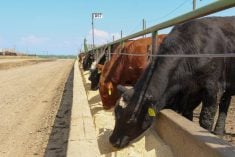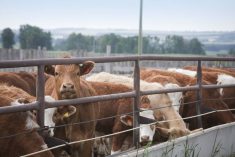At the time of writing this article, April 2025 live cattle futures were trading just above $197, which was a fresh contract high.
The market appears to be incorporating a risk premium due to uncertainty in beef production in both Canada and the U.S. This has provided Alberta feedlot operators opportunities to lock in favourable margins for the second quarter of 2025.
Feeder cattle prices for short-keep replacements have surged over the past month as the margin structure has improved. Cattle producers have been inquiring over the past month regarding the price outlook for the first and second quarters of 2025.
Read Also

Gentle treatments for pain in the neck
Heading toward year-end, people unknowingly tense up against the cold and busyness, causing neck pain that can often be treated with appropriate support and gentle mobility, athletic therapist Kathlyn Hossack says.
Cow-calf producers are looking for marketing signals on yearlings while backgrounding operators are also timing sales on fall-placed calves. Therefore, in this issue, I’ll discuss the fed cattle supply projections for the first half of 2025.
U.S. cattle and calves on feed for slaughter in feedlots with 1,000-plus-head capacity as of Dec. 1 totalled 11.982 million head, down 34,000 head or 0.3 per cent from the Dec. 1, 2023 number of 12.016 million head. U.S. feedlot placements during November were 1.796 million head, down four per cent or 69,000 head from the November 2023 figure of 1.865 million head. U.S. feedlot marketings during November were 1.725 million head, down 26,000 head or one per cent from November 2023 marketings.
The U.S. Department of Agriculture’s December Cattle on Feed report was considered neutral for the market in the short-term. Most cattle producers look at the first page of the report. However, the important data is on page five of the report, which shows feedlot placements by weight category. In Table 1 here we have the placements by weight category from the August through December Cattle on Feed reports.

During August and September 2024, total U.S. feedlot placements were down 69,000 head from the same months of 2023. During this same time frame, feedlot placements under 800 lbs. were down 115,000 head. We assume that the placements gain about three pounds per day. Feeder cattle under 800 lbs. probably gain about 2.3-2.5 lbs. per day on average while feeder cattle over 800 lbs. probably gain about 3.3-3.5 lbs. per day on average.
We can add up the number of cattle that will be available for each month. For our April projection, we would start with the August 2024 placements under 600 lbs. Onto this number, we would add the September placements in the 600- to 699-lb. category and the October placements in the 700- to 799-lb. category and so on.
We need the December and January placements to project the total number of cattle available for April but we have a good idea how the trend is developing.

Notice in Table 2 that the number of steers and heifers available in April is projected to be only 1.653 million head, down 50,000 head from April 2024. This is also the lowest number of cattle available in the first half of 2025.
If we do the same exercise for the Alberta and Saskatchewan Cattle on Feed reports, we could see a year-over-year decline of 15,000 in April and 21,000 head in May. Market-ready supplies of fed cattle will be down sharply from year-ago levels on both sides of the border during April and May.
The year-over-year decline in market-ready fed cattle supplies is considered bullish for the feeder market during the spring of 2025. It appears feedlot operators will experience healthy margins which will cause them to bid up the price of replacements. Strength in nearby April live cattle futures will pull up the deferred contracts as well.
The live cattle futures complex has a characteristic known as the “constellation of prices.” This is where the deferred live cattle futures behave or move in tandem with the nearby contract.
If the April live cattle contract is making fresh contract highs in late March, the June and August live cattle futures will also be making fresh contract highs even though market-ready fed cattle numbers are higher in June compared to April. Plan to sell your yearlings or backgrounded cattle in the spring.
















